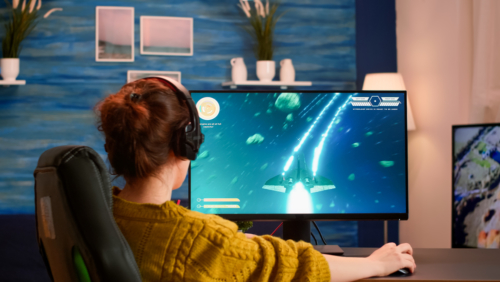The need for Game testing has exploded on the back of the vertiginous 9% year-on-year growth of the gaming market. With more connected devices, various playing platforms, and a global market thirsty for gaming, the need for game testing has never been more vital.
Game development is an exciting process, particularly for creative types. But not every part of the process is fun and exciting.
Game testing, for instance, can be tedious. The testing team has to go through every nuance of the video game to identify bugs so the development team can fix them. It requires hours of work and a lot of patience.
But it’s key to ensuring you’re releasing a high-quality game. Imagine what would happen if you skimped on testing and went to market with a bug-ridden product?
- Angry emails.
- One-star reviews.
- Thousands upon thousands of dollars—out the window.
So while it may be tempting to think about game testing as a roomful of gamers playing video games all day, it’s a critical part of your process.
Let’s walk through what game testing is, the different types of testing, and some tips to help you go to market with a stellar product.
What Is Game Testing and Why Is It Important?
Game testing, simply put, is a quality control process for gaming software.
It typically features a live human tester, although in some cases, the testing can be automated. Typically, the game tester will push the game to its limits, attempting to do things the average user may not do, like getting stuck in a wall or another obstruction.
Game testing is a critical part of the game development lifecycle. The reality is that there are always bugs that come up during the development process. The sooner developers identify them, the better things will be down the line, and the less money you’ll need to spend overall.
Because game testing is so vital, it’s important to use the right testing team. Testers should be experienced and well-versed in software testing.
A video game or mobile game tester isn’t merely playing games. They’re ensuring the software works as it should, checking every possible scenario for issues, and looking at whether or not the game offers an immersive experience players will enjoy.
They work under strict deadlines, often playing a game multiple times just to ensure everything works.
What Are the Two Main Categories of Game Testing?
Although game testing has many components, they fall into two buckets: playtesting and quality assurance (QA) testing.
Both are critical to ensure that the games function well on the back end and provide an exceptional user experience on the front end.
Playtesting
Playtesters specifically focus on testing the game’s user experience. Rather than diving into technical issues, coding errors, and the like, playtesters look at issues that an average player would recognize, for example:
- Boring or vague moments that cause the player to lose interest
- Long spans without a victory or accomplishment to keep the player engaged
- Areas where a player can become trapped
- Movement graphics that aren’t working
- Spots where the controls don’t feel intuitive
- Places where the game is too confusing or the player doesn’t have the tools to piece together their objective
At the end of the day, playtesters ensure that the game is an overall enjoyable experience for the player.
Generally, playtesting happens in four stages:
- Gross playtesting: Testers use a basic running model to find problems in gameplay.
- In-house playtesting: This is a more comprehensive test to find any remaining glitches.
- Blind playtesting: In this case, testers have no prior knowledge of the game.
- Final playtesting: This stage is used to improve design and aesthetics.
QA Testing
The second, and often more involved, area of game testing is QA. This is where the tester focuses on identifying technical issues within the game, like glitches, bugs, and inconsistencies.
Generally, QA testing requires a more specific set of knowledge than playtesting, as the QA testers need to be familiar enough with the system to know what to look for.
There are multiple types of QA game testing:
- Functional testing: This type of testing is a general test to ensure every part of the game works as promised.
- Compatibility testing: The tester makes sure the game works with every piece of hardware, graphics, or software configuration.
- Performance testing: The tester determines how the game performs under various battery or network conditions and different memory capacities.
- Localization testing: This part of the testing process is especially important for international companies—it ensures the game functions properly in different languages.
What Does the Game Testing Process Look Like?
Testing games is complex. But the more you know about how the process works and where it fits within the entire development lifecycle, the better equipped you are for success.
Before digging into the process for video game testing, let’s look at where testing fits within the game development lifecycle.
Game Development Lifecycle
Here are the main stages of game development:
1. Concept Analysis
Before development even begins, game designers spend long hours creating the game’s ideas and concepts. Storyboards, characters, settings, environment—these are the first elements created.
2. Game Planning
Once the game’s creative direction is set, game planning can begin. This step involves creating three documents: a game design document, a technical design document, and a project plan.
3. Game Development
Developers then get straight to work on a prototype. The prototype gives the team a tangible idea of what the gaming experience will be like. Once they approve the prototype, the developers create a full-fledged application.
4. Game Testing
As with any major project, very little goes perfectly in the initial development stages. That’s where testers come in: they rigorously test every scenario of the game.
When defects arise, they provide detailed notes to the developers to avoid problems in later releases. Often this results in multiple cycles of testing and resolving until the game is ready for pre-launch.
5. Pre-launch
After the testers complete their work, developers resolve all bugs and put on the final touches for market deployment.
6. Launch
The big day has arrived: the game is ready to go to market! This is the exciting part, where the whole team gets to enjoy the fruits of their labor.
7. Patch & Update
Once the game is released, however, the work isn’t done. Inevitably bugs will come up, prompting developers to create patches and release updates.
If the developers decide to release updates or expansions to the game, then game testers will need to come back in and repeat the process for each new element.
Game Testing Lifecycle
Now that you know where game testing fits into the game development lifecycle, let’s unpack the process video game testers go through to ensure they’re best prepared to spot and report those issues.
1. Put Together a Game (Testing) Plan
A failure to plan is a plan to fail, and game testing is no exception. The game developers initiate the process by identifying where the game sits in the development lifecycle. This helps determine what types of testing are necessary.
After that, the team creates a game testing plan. This involves answering:
- Who will be involved in testing?
- What equipment does the team need?
- Will the testing site be on-premise or virtual?
- What is the time frame for the test?
Once these questions are answered, the team should have adequate information to prepare.
2. Prepare the Environment
The preparation stage involves putting together everything the game tester needs to do their job. Developers will update their documentation, set up test documents, and prepare test environments.
Basically, they want everything to be ready so that when the game tester shows up, it’s go time.
3. Unleash the Game Testers
The testing team’s job is to find as many ways to break the game as humanly possible.
Often, a tester won’t just settle for finding a single defect. They’ll test around the issue, trying to figure out its full extent and gather information.
4. Report Each Issue in Detail
Every time they find an issue when testing games, they’ll write a detailed bug report and immediately submit it to development.
In a bug report, the tester will include where they found the bug and how to reproduce it. The more detail, the better.
5. Repair Issues
The developer will then take that bug report and fix it. Sometimes, this will require bringing the tester in to fill in the gaps and answer additional questions.
6. Repeat
After a game testing period is complete, the developers will fix those bugs and send an updated build. Testers will then test the updated build—both the areas where the bugs occurred and potential new bugs that come up.
READ MORE: Here’s a real-life example of how game testing is used for software QA.
Tips for Better Game Testing
Whether you’re a game tester yourself or evaluating game testers to work on your project, here are some of the best practices top-performing testers follow.
1. Do Your Homework
Although testing games sounds fun, it’s still a job. Professional testers will come prepared so they can jump right into testing. They’ll read the game’s documentation to gain a sense of familiarity with the game itself, which will make it easier to navigate issues later on.
Reading the game documentation also gives you a common vocabulary with the developers, ensuring better, more effective communication.
2. Create a Detailed Repro
When you identify an issue, it’s critical that you provide a repro (reproduction) that lays out exactly what steps you took to cause the issue. If the developers can’t duplicate the error, they won’t be able to find out what caused it.
One great way to do this is through video recording. This eliminates the barrier of written text—developers can watch your repro and follow along in real time.
3. Continually Test & Re-test
As we mentioned during the game development lifecycle, the testing process is never complete. Often when developers fix an issue from a previous build, it causes a problem in the next build.
That’s why it’s critical to re-test every element of the game in subsequent builds. It may seem tedious and time-consuming, but it’s better than going to market with a bad product.
4. Clarify Confusion Early & Often
There’s nothing worse than getting into the home stretch only to find out that a tester missed a bunch of bugs because they didn’t understand what was going on.
If you don’t know something, whether it’s a specific feature or a general game attribute, don’t hesitate to ask.
The more you understand the game, the better your feedback will be. Conversely, if you don’t understand the game, you may offer unhelpful feedback—wasting your time and the developers’.
5. Test on Multiple Devices
We live in an omnichannel world. Games are rarely limited to single-device usage, which makes testing games that much more complicated.
A thorough game test will include multiple devices. This should be spelled out in your game testing plan. If not, you should reach out to your developers for clarification.
What’s more, sometimes a bug will arise not just in the game itself but within your equipment. When you test with multiple devices, you can weed out these issues caused by user error.
6. Report as Soon as You Confirm a Bug
Most importantly, timing is key when it comes to testing any type of software. Once you spot an issue, make sure you report it immediately.
This is a best practice for multiple reasons. First, it’s easy to forget things. Instead of “getting around to reporting it,” just do it in the moment.
Also, in development, sometimes a few days can make a difference. Report the bugs as quickly as possible, so the developers can prioritize and move the project along that much faster.
Conclusion
At the end of the day, testing games isn’t a simple practice. It’s a fairly involved process that requires multiple steps and a lot of attention to detail.
It’s also a critical part of the game development strategy. After all, the worst time to spot a bug in your game is once it’s in the market. As tedious as game testing can be, it’s the best place to catch these inevitable issues.
By having an experienced, process-driven game tester, you can make sure that you’re catching bugs early and often. That’s where we can help. XBOSoft testers specialize in ensuring software quality.
If you’re looking for an experienced game testing partner, learn more about our mobile game testing services.
Need Help with Your Video Game Testing Strategy?
Most Popular
 |
A Quick Introduction To Jira
By: Jimmy Florent |
|
 |
Visual Regression Testing Market Challenges and Opportunities
By: Philip Lew |
|
 |
Agile Testing Solution Market Continues to Grow – What Are The Key Challenges?
By: Philip Lew |
|







Leave A Comment